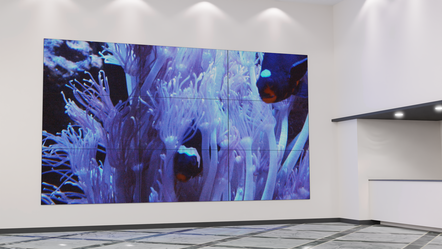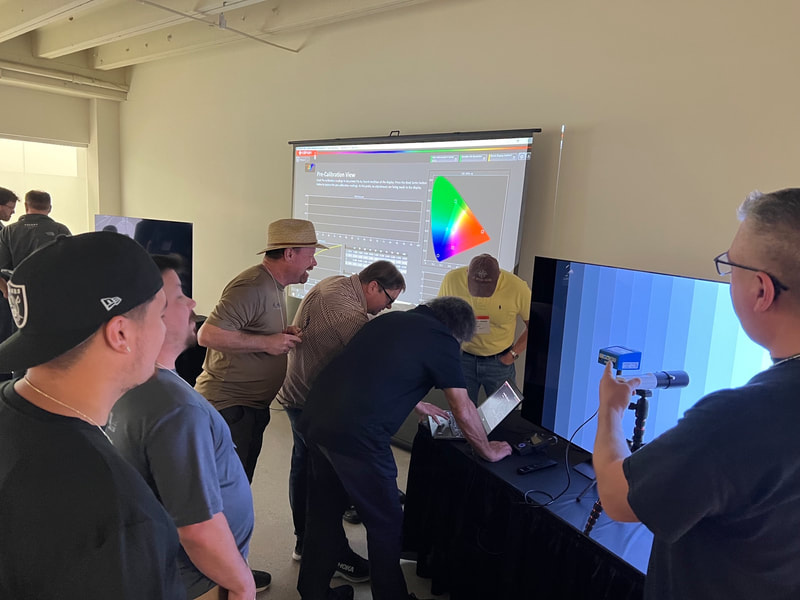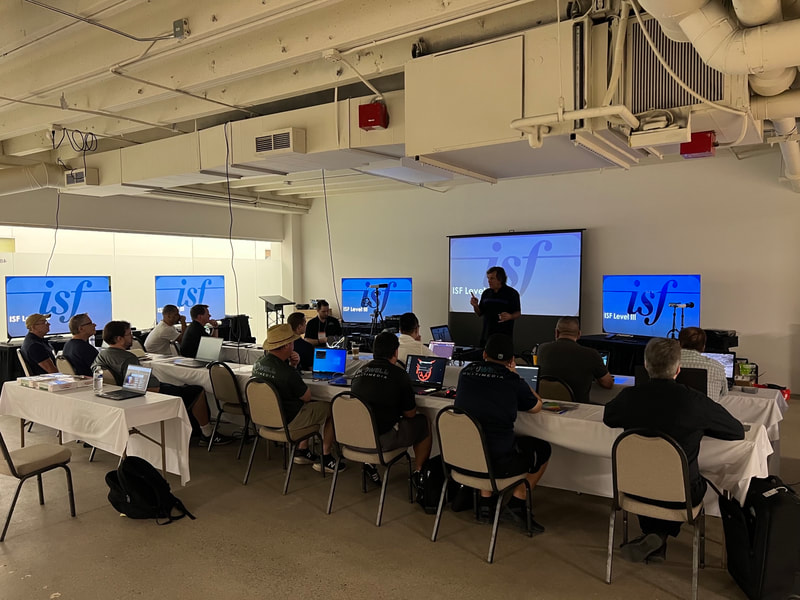|
Written by Michael Hamilton  I have been with Murideo since April of 2022 in the role of Technical Writer, unequivocally loving every nanosecond. In forty-seven years prior, I had worn nearly every industry hat that existed. Twenty-eight of my latest years have been in close association with the Imaging Science Foundation (hereafter, ISF), the past fifteen with instructor status. Most recently, prior to Covid effectively shutting tinsel town down, I was calibrating professionally in Hollywood at every level from content creation through the complete production cycle for David Abrams at Avical, my great friend, as he is as well to everyone with our Murideo team. Additionally, I will include I also do product reviews for Sound & Vision magazine plus the online website Projector Central. Be assured, this is not a résumé, rather an illustration of how video calibration has been thematic throughout my past three decades. Murideo’s and ISF’s Jason Dustal and myself work from the AVPro Tampa office, giving me an opportunity to see Jason almost daily instead of only during our past trade show rituals and we frequently interact, as assisting Murideo also resides under my umbrella. With Covid essentially in the rear-view mirror, commercial and residential custom installation have returned to what we previously referenced as normal. With every facet of training having resumed, including AVPro Academy and ISF seminars, Jason has received perspectives regarding video calibration – both interesting and unsettling – from some in the USA custom integration community. I’d like to take full advantage with this opportunity to bring attention to the reasons we feel video calibration continues to merit your full consideration and the impact delivering it as a service offers a company, while alternatively, highlighting the disadvantages for dismissing calibration as unnecessary and not needed. A TREND? In two of the most recent ISF seminars, one in New York at Able Cine, the other in SoCal at Stewart Filmscreen, a majority of attendees were from within the film production community. While having content production related attendees is not new or unusual, their dominating seminar attendance since the resumption of training represented an unexpected modulation to our expectations. When Covid forced virtually the entire post-production industry into working from home, on-staff and third-party calibrators were unable to maintain required calibration maintenance. Reference and production monitors are routinely calibrated. Many studios and post-houses stipulate the calibration process be performed once per calendar quarter. Despite the parts precision and inherent stability of these displays (most costing $30,000 and up), consistency to maintain continuity is critical. For example, two colorists independently working on differently-timed segments of the same scene (one minute of theatrical content often may take days to finalize), with separate but identical monitors that do not match makes for a costly, time-consuming disaster when the deliverables are returned with the show-runner citing incongruities. While that is certainly a Hollywood first-world problem and nothing an integrator would encounter, it is presented to underscore the degree in which calibration is vital and on-going inside the content-creation / production chain, all to assure the end product reaching the consumer adheres to the impeccable standards of organizations such as the Society of Motion Picture and Television Engineers (SMPTE) and the International Telecommunications Union (ITU). And let’s not forget the mind’s eye where content starts… director’s intent. Many broadcast and production monitors calibrate easily (when mastered) and as the production community attendees relayed to us, studio IT directors wish to broaden the skillsets of a greater number of individuals inside their departments. Hollywood, New York, London…all film and television-centric communities with craftspeople who tirelessly devote their lives to the flawless transition of action on the set into the suspension of belief we devour in our homes. So why are only a dedicated few in the domestic custom integration community paralleling this vitality by delivering, and in some cases even eclipsing Hollywood, with first-class image fidelity so easily attainable with today’s cutting edge products? ARE YOU ON THE ISF WEBSITE? As of late, efforts are underway to confirm whether companies listed on the ISF website continue to calibrate, if their equipment is current and able to contend with today’s display technologies, and if no longer calibrating, what might be the reason. Attrition plays its part, as we discover a percentage of companies are no longer in business. Others indicate they have equipment, but the person trained is no longer with the company, and the equipment has just been setting. Yet, other responses are more intriguing. Many respondents declare TVs are so good these days, there is no longer a need to calibrate. Some falter, resorting to “nobody ever asks for it”, and one declared emphatically “that was just for tube TVs”. WHY CALIBRATE? HERE ARE JUST A FEW REASONS… Let’s examine why for many custom integrators, especially those who also do commercial installations, calibration is as important as – and no different than – programming automation, security, or lighting. FLAT PANEL CALIBRATION Out-of-the-box (OOTB) default settings must comply with Energy Star 6.0 requirements, which force manufacturers into OOTB defaults that make energy savings a priority over image fidelity. Many TV makers conclude this setting should provide an inoffensive level of light output for a darkened viewing environment, as a most-common use scenario. Consequently, in a moderate or heightened ambient light environment, the picture is likely to be considered too dim. VIEWING ENVIRONMENT OOTB settings, if left untouched are ideal for a single set of viewing circumstances with regard to ambient light levels. While pre-set Picture Modes often boost (or subtract) a display’s light output, making these changes alters color balance. A picture mode with associated settings perfect for daytime viewing will provide too much light output for comfortable nighttime viewing. Some dealers automate Day and Night viewing, based on the system’s astronomical clock setting, by auto-switching picture modes. Or, provide for manual selection via system interfaces. DEFAULT SETTINGS Motion, Clarity and Noise-oriented settings typically impact picture quality when left at defaults or set incorrectly. Fluidity of motion can look unnatural, definition of fine detail can be induced into blurring, while controls designed to reduce noise artifacts, if improperly adjusted, can introduce additional noise that is not part of the original signal. Overscan default settings (i.e.: Screen Size, Fit To Screen, etc.) by most manufacturers are incorrect OOTB. They purposely Overscan the image by as much as 4% to conceal satellite or cable system “data noise” which may appear on channels that display legacy content. Manufacturers are not wrong to do this, it reduces returns from end-users who suspect the TV has a problem. When left incorrectly set (or at default), processing unnecessarily re-scales the image, resulting in visible errors and missing picture information. MISLEADING PICTURE MODE LABELING “ISF Light”, “ISF Dark”, “Film Maker Mode” and “IMAX Enhanced” are NOT pre-calibrated picture modes! They are easily identifiable, additional memory locations and when in those modes, turn off many features which inhibit image fidelity. On LG televisions when professionally calibrated, ISF modes change their labels to ISF DAY and ISF NIGHT, plus are (optionally) lockable to prevent inadvertent end-user changes. Closest to accurate images, these modes are perfect calibration starting points. TV REVIEWS AND RANKINGS Savvy consumers research print and online reviews prior to television or projector purchases. Nearly every review draws conclusions citing pre-calibration and post-calibration measurement data, along with the reviewer’s analysis of the product’s performance. Selling and installing favorably reviewed TVs minus calibration does not deliver the image quality an end-user anticipates from his research. By down-playing calibration as unnecessary or not needed, you may find yourself in a pickle from which you cannot be easily removed. Worse, your client may seek one of your competitors for a calibration solution, perhaps during the proposal stage, jeopardizing the entire project.  VIDEO WALLS Multi-panel video walls, despite being comprised of identical models adjusted to identical settings, seldom match due to the degree parts tolerances differ and more simply, from internal service mode settings, particularly if the units were manufactured at different times during the product’s lifecycle. Parts substitutions and firmware revisions almost assure no two panels will match perfectly OOTB at installation. And as the wall wears in with run time, the differences become exaggerated. Commercial integrators recognize how calibration enhances their reputations when light and color levels blend seamlessly and appear uniform. MULTI-DISPLAY AND MIXED TECHNOLOGY INSTALLATIONS Uncalibrated, multiple TVs seen from a common spot of observation, especially when different sizes or from different manufacturers (not advisable), will not match one another, and may prove acceptable to the client. Similarly, uncalibrated mixed technology installations will substantially differ and appear distractingly mis-matched (perhaps in a residential end-user’s sports bar-themed multi-TV installation, where a large OLED TV is flanked by smaller-sized LCD TVs). A talented calibrator will adjust each display with instrumentation, and then perform final fine-tuning by “perceptually” matching the multiple LCDs to the OLED. Because human vision perceives technology types differently, the calibrator will perform the final match “by eye” to create a uniform look for all. Mixing technology types in this manner is not recommended. TELEVISION R&D, ENGINEERING AND ELEVATED PARTS COSTS ENABLE PRECISE COLOR ADJUSTMENT In a manner of speaking, a substantial portion of the cost of a calibration has already been paid for by the consumer. Kooky talk, you say? Allow me to explain. For a display to calibrate correctly, parts precision is necessary to deliver the desired calibration results. Software-driven calibration controls onboard a TV have an R&D history which are also reflected in the manufacturer’s dealer cost. All that remains is a qualified technician to hyper-tune the display, in the environment in which it will be viewed. There are hundreds of controls inside today’s displays. What do manufacturers know that you don’t? PROJECTION SYSTEM CALIBRATION Practically an article unto itself, but plainly stated: It is impossible to deliver an accurately set up projection system without calibration. Unlike flat panels, projection is considered a “system” consisting of projector technologies paired to screen formulations which consist of a variety of materials and gain factors, within viewing environments that may vacillate between dual-use with diffuse lighting to cinematically dark. New light engine technologies like laser-based machines, available for a number of years and now with a track record, are reported to require more frequent calibration service due to color balance stability drifting, while lamp-based projectors need periodic lamp replacement. Calibrating companies recognize that while this required maintenance provides an opportunity for superlative customer service, it is also represents recurring revenue. UST projectors and ALR screens represent the fastest growing segment for two-piece projection. Considered dual-use, as in day / night, calibration is crucial to deliver the best result to the client. Calibration demonstrates your company delivers what the manufacturer and more importantly, the content creator intended. A final observation somewhat amuses me, were it not for the punitive nature of the irony. CEDIA, in its Integrator of 2027 white paper, discusses at length how integrators who address aspects of wellness technology will discover new opportunities with existing technologies they already are specialists with. An example used was circadian lighting, where integrators bring the outside indoors with D65 lighting scenes…the same D65 white point that most integrator neglect to calibrate installed video displays at.
Some dealers routinely calibrate every display from forty-nine inches and up. They do not make calibration a line-item but include the cost to the client in the programming labor total. Essentially, calibration may be thought of as a specialty discipline in the same vein as automation, lighting and security programming. It may be effectively promoted once equipped with the correct information. We encourage anyone with an interest in video calibration worldwide to inquire about ISF seminars sponsored by AVPro Edge and Murideo. Change your life and the lives of your clients, be the company in your marketing area that is viewed as the true specialist.
0 Comments
Leave a Reply. |
Third Party Reviews & Articles
SIX-G Generator
Archives
July 2024
Categories |
|
|
© Copyright 2015-2023
Home Contact Us About Us Careers Warranty 2222 E 52nd Street North, Suite 101, Sioux Falls SD 57104 +1 605-330-8491 [email protected] |





 RSS Feed
RSS Feed